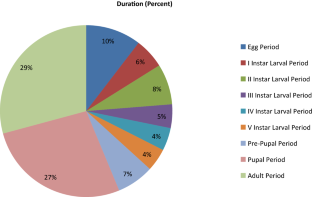Report of morphomatric and biology of leaf eating caterpillar, Diaphania indica in arid region of India
Research Articles | Published: 14 July, 2021
Online ISSN : 2229-4473.
Website:www.vegetosindia.org
Pub Email: contact@vegetosindia.org
First Page: 800
Last Page: 806
Views: 2209
Keywords:
Diaphania indica
, Cucurbits, Biology, Morphomatric analysis
Abstract
Present paper deals with the morphomatric analysis, incidence and biology of leaf eating caterpillar, Diaphania indica, carried out on cucurbits in arid region. The incidence of leaf eating caterpillar was first reported on fruits of different cucurbits and highest fruit infestation was recorded in muskmelon followed by round melon and watermelon fruits at farm of ICAR-CIAH, Bikaner. Eggs are laid on leaves or young shoots or fruits. The female fly laid the eggs in the cavities made by the ovipositor, just beneath the skin of the fruit. The pooled mean duration of the different stages of D. indica viz., the female fecundity (163.35 number), egg period of 3.59 days, larval period of 9.10 days, pre-pupal period of 2.14 days, pupal period of 9.33 days and adult longevity of 10.08 days, respectively. The length of Ist instar larvae is 4.30 ± 0.135 mm and width is 0.53 ± 0.019 mm. The fifth instar larva is 18.10 ± 0.125 mm length and 3.28 ± 0.043 mm width. Pupa is 13.66 ± 0.088 mm length and 2.28 ± 0.043 mm width. Adult female body length was 11.19 ± 0.211 mm and width 24.54 ± 0.201 with wing expansion. The male body length is 11.00 ± 0.159 mm and width 22.85 ± 0.156 mm with wing expansion. The morphometric variations of different life stages of the D. indica have been recorded. Growers can adopt this study for the timely management of D. indica in arid condition.

(*Only SPR Members can get full access. Click Here to Apply and get access)
References
Barma P, Jha S (2014) Studies on bio-ecology and voracity leaf roller (Diaphania indica Saunders (Lepidoptera: Pyralidae) on pointed gourd. Acad J Sci 9:2790–2798
Bhargava R, Gurjar K, Haldhar SM, Singh RS, Sharma BD (2016) Impact of water stress on photosynthesis and secondary metabolites in snap melon and musk melon. Indian J Arid Horti 11:30–35
Chakravarthy HL (1982) Cucurbitaceae: fascicles of flora of India. vol 11, pp 1–136
Choudhary BR, Haldhar SM, Maheshwari SK, Bhargava R, Sharma SK (2015) Phytochemicals and antioxidants in watermelon (Citrullus lanatus) genotypes under hot arid region. Indian J Agric Sci 85(3):414–441
Choudhary BR, Haldhar SM, Maheshwari SK, Bhargava R (2016) Sources of variation in sponge gourd breeding. J Agric Eng Food Tech 3(1):58
Ganehiarachchi GASM (1997) Aspects of the biology of Diaphania indica (Lepidoptera: Pyralidae). J Natl Sci Found Sri Lanka 25(4):203–209
Haldhar SM (2012) Report of Homoeocerus variabilis (Hemiptera: Coreidae) on khejri (Prosopis cineraria) in Rajasthan, India: incidence and morphometric analysis. Florida Entom 95:848–853
Haldhar SM (2013) First record of the flower beetles, Mylabris macilenta, Anthicus crinitus and Anthrenus subclaviger in watermelon in arid region of Rajasthan. ICAR-CIAH News Letter, July–December, 2–3
Haldhar SM (2016) New report of beet armyworm, Spodoptera litura in ridge gourd (Luffa acutangula). ICAR-CIAH News Letter, July–December, 2
Haldhar SM, Choudhary BR, Bhargava R, Sharma SK (2014) Development of an organic integrated pest management (IPM) module against insect-pests of muskmelon in arid region of Rajasthan India. J Exp Biol Agric Sci 2(1):19–24
Haldhar SM, Bhargava R, Singh RS, Krishna H, Sharma SK (2015) First report of Colotis amata (Lepidoptera: Pieridae) on Salvadora persica (Capparales: Salvadoraceae) in Rajasthan, India: incidence and morphometric analysis. Florida Entom 98(2):442–445
Hosseinzade S, Izadi I, Namvar P, Samih MA (2014) Biology, temperature thresholds and degree-day requirements for development of the cucumber moth, Diaphania indica, under laboratory conditions. J Insect Sci 14:1–6
McSorley R, Waddill VH (1982) Partitioning yield loss on yellow squash into nematode and insect components. J Nematol 14:110–118
Mohaned MA, Mohamed M, Elabdeen HZ, Ali SA (2013) Host preference of the melon worm, Diaphania hyalinata L. (Lepidoptera: Pyralidae), on cucurbits in Gezira State, Sudan. Persian Gulf Crop Protec 2(3):55–63
Nagaraju MC, Nadagouda S, Hosamani AC, Hurali S (2018) Studies on biology of cucumber moth, Diaphania indica (Saunders) (Lepidoptera: Crambidae) on bitter gourd. Intern J Curr Microb Appl Sci 7:4511–4516
Peter C, David BV (1991) Population dynamics of the pumpkin caterpillar, Diaphania indica Saunders (Lepidoptera: Pyralidae). Intern J Pest Manag 37:75–79
Rahman AHMM, Anisuzzaman M, Ahmed F, Rafiul Islam AKM, Naderuzzaman ATM (2008) Study of nutritive value and medicinal uses of cultivated cucurbits. J Appl Sci Res 4(5):555–558
Acknowledgements
The authors are thankful to Director, ICAR-Central Institute for Arid Horticulture, Bikaner, India, for providing facilities and advice required for experimentation, and to R. Swaminathan, Professor, Department of Entomology, MPUAT, Udaipur, India for critical discussion and suggestions.
Author Information